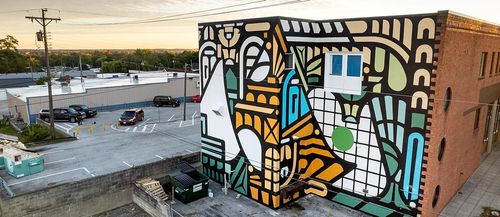Greencastle has come alive with colors, thanks to the highly-anticipated Putnam County Mural Exhibition. This year, seven talented artists from across the world have transformed the town’s walls into dynamic, large-scale works of art, enriching the local landscape with creativity and bold expression. The town has become a living gallery, where each mural tells its own story and invites its viewers to pause and reflect. On Sept. 17, these artists came together at the Peeler Art Center to share their creative journeys, offering unique perspectives on their craft and how public art connects with the community.
The Murals Project received an overwhelming 284 applications this year. After much deliberation, seven artists were chosen to participate: Anthony Brooks, Naomi Haverland, Emily Eldridge, Brooke Smart, Noe Barnett, Matt Rees and Holly Sims. Each artist brought something unique to the table, making the panel discussion lively and insightful. Their experiences and personal stories revealed not only the artistic process behind mural-making but also the deeper meaning behind these public works of art.
One of the central themes of the discussion was how different each mural project can be. According to Anthony Brooks, "no two murals are ever the same." He explained that the preparation process is influenced by a variety of factors, such as the condition of the wall, the space available and the composition of the artwork itself. For Brooks, a mural is much more than just a painting on a wall—it is a collaboration between the space and the artist’s vision, one that requires careful consideration and planning.
Brooke Smart, another participating artist, highlighted how the audience itself can play a role in shaping the final piece. She shared a heartwarming story about a kindergarten class that would look out their window every day as she painted a mural on a circular water tank. As the mural began to take shape, they would enthusiastically wave and smile at her. "It was such a beautiful moment," Smart recalled. "The mural started to mean something more, not just to me, but to those kids who saw it evolve day by day."
Perhaps one of the most thought-provoking parts of the discussion came when the artists were asked how they disconnect from their artwork after it is completed. Noe Barnett shared an inspiring philosophy, explaining that his work often features motifs like flowers and fruits, which are not meant to last forever. He finds a poetic connection between the ephemeral nature of his subjects and the impermanence of murals. "Beautiful things are temporary," Barnett remarked. "And that’s what makes them special." The artists’ acceptance of impermanence also underscores the fact that murals are often subject to natural elements, urban development and public opinion—none of which the artist can fully control.
As public artworks, murals naturally invite a range of reactions from those who encounter them. The artists shared various experiences, both positive and challenging, with how the public has responded to their work. Emily Eldridge recalled how some of her murals received harsh criticism from certain viewers. "Some people just hated it," she said with a laugh, explaining that public art can sometimes provoke strong emotions. Smart had a different experience with her mural in a small town, where an older woman expressed her displeasure because people used to take family photos in front of the wall before the mural was painted. While the mural had disrupted a local tradition, it also sparked a conversation about how public spaces evolve and the role art plays in that transformation.
Naomi Haverland spoke about the overwhelming support she received while painting, especially from children who would wave and cheer for her as she worked. She called this energy a "force of positive reinforcement" that kept her motivated throughout the project.
One of the recurring themes throughout the discussion was the impact of bringing professional art to smaller communities like Greencastle. Eldridge expressed her passion for working in rural areas, noting that "cities get everything," while smaller towns are often left out of the cultural conversation. "I want to bring art to places that don’t usually get it," Eldridge said, emphasizing the importance of making art accessible to everyone.
Near the end of the discussion, Barnett expressed how creating murals is often a humbling experience. He shared a story about painting on a building that was over 200 years old and how learning about the history of the structure added layers of meaning to his work. As you walk the streets of Greencastle, take a moment to step back and appreciate the murals that now adorn its walls—they are not just paintings but a reflection of the town’s evolving identity.

